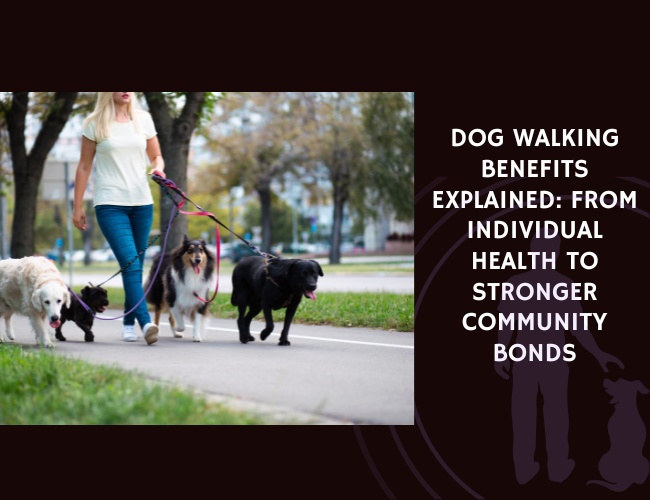Introduction: The Multifaceted Impact of Dog Walking
Dog walking is not just an everyday activity for pet owners; it has profound implications for both individual and community health. Engaging in regular dog walks offers a range of benefits, encompassing physical, mental, and social dimensions. As urban environments grow and lifestyles become more sedentary, the significance of dog walking is increasingly recognized.
Contributions to Individual and Community Health
Dog walking is one of the simplest and most effective ways to promote physical activity among individuals. Regular walks can lead to improved cardiovascular health, better weight management, and enhanced overall physical fitness. Studies have shown that dog owners tend to engage in more consistent physical activities, leading to improved heart health and reduced risks of obesity and chronic diseases like hypertension and diabetes.
Beyond physical advantages, dog walking also fosters mental good health. Walking a dog provides structure and purpose, helping to reduce stress, anxiety, and depression. The companionship of a dog, coupled with the benefits of outdoor exercise, promotes the release of ‘happy hormones’ like oxytocin and endorphins, making owners feel more content and less stressed.
Socially, dog walking is a powerful tool for community building. Dog owners frequently interact with each other during walks, which helps forge personal connections and can lead to lasting friendships. This sense of community is crucial for mental well-being and helps in creating a supportive network among neighbors.
Physical, Mental, and Social Benefits
Physical Benefits
- Cardiovascular Health: Regular dog walking is associated with improved cardiovascular health. Dog owners often walk more and have better heart health compared to those without dogs.
- Weight Management: Walking dogs aids in maintaining a healthy weight, reducing the risk of obesity, and managing chronic conditions like diabetes and hypertension.
- Mobility and Joint Health: Particularly for the elderly, regular walking enhances mobility and joint health, decreasing the risk of falls and other mobility-related issues.
Mental Benefits
- Stress Reduction: Walking a dog can substantially reduce stress levels. The routine and company of a dog offer emotional stability and stress relief.
- Enhanced Cognitive Function: Exposure to nature during walks boosts cognitive function and improves mood. It helps in mitigating the mental fog and emotional instability often seen in hectic modern lives.
- Mental Resilience: Regular interactions with dogs and the structured routine of walking can build mental resilience, enabling individuals to better cope with everyday stressors.
Social Benefits
- Social Interaction: Dog walking encourages social interactions, creating opportunities to meet and engage with other dog owners. This interaction can lead to building a strong sense of community.
- Community Trust: Increased interaction and familiarity among dog walkers can enhance neighborhood trust and safety, contributing to a more connected and watchful community.
Growing Importance in Urban Life
The benefits of dog walking are particularly pronounced in modern urban settings. As cities expand, the necessity for walkable spaces and green areas becomes evident. Urban planning that prioritizes accessible sidewalks, parks, and trails not only encourages dog walking but also promotes a healthier, more active lifestyle for all residents.
Moreover, as urban life becomes more stressful, the mental health benefits of dog walking become crucial. The simple act of walking a dog integrates exercise into daily routines and provides a necessary break from the urban hustle, leading to a more balanced and peaceful life.
As we delve further into this topic, we will explore the specific physical health benefits dog walking provides. Regular dog walks offer a significant advantage in maintaining both personal health and fostering a cohesive community spirit, making dog walking an indispensable activity in our daily lives.
Physical Health Benefits
Cardiovascular Health and Physical Fitness
One of the most profound advantages of dog walking lies in its contribution to cardiovascular health. Regular walks with dogs significantly boost physical activity levels. According to studies, dog owners tend to walk more frequently and for longer durations, compared to those without dogs. This increase in physical activity translates to enhanced cardiovascular health and reduced blood pressure among dog owners. Incorporating merely 30 minutes of brisk walking into a daily routine can lead to noteworthy improvements in heart health.
Weight Management and Chronic Disease Prevention
Dog walking is a powerful tool in managing weight and preventing chronic illnesses such as obesity, diabetes, and hypertension. Regular physical activity through dog walking helps maintain a healthy weight by burning calories and improving metabolic functions. Research indicates that dog owners are less likely to be overweight compared to non-dog owners. Additionally, staying active through dog walking can lower the risk of developing lifestyle-related chronic diseases.
Mobility and Joint Health in Elderly Populations
For elderly individuals, dog walking holds significant benefits for maintaining mobility and joint health. Regular walks help older adults stay active, which is crucial for preserving physical function and minimizing the risk of falls. Walking also supports joint health by promoting flexibility and reducing stiffness. Moreover, the companionship of a dog provides older adults with added motivation to engage in physical activity, thereby contributing positively to their overall well-being.
As we delve deeper into the myriad benefits of dog walking, it becomes evident how this simple activity bolsters both individual health and community cohesiveness.

Mental Health and Emotional Well-being
Reducing Stress, Anxiety, and Depression
Dog walking has been shown to significantly reduce stress, anxiety, and depression. Engaging in this activity can provide individuals with a sense of purpose and routine, which is especially beneficial for those experiencing mental health challenges. During walks, interacting with dogs helps release oxytocin and endorphins—hormones associated with happiness and stress relief. This natural boost in mood leads to a reduction in feelings of anxiety and depression, allowing individuals to enjoy a more balanced state of mental well-being.
Benefits of Nature Exposure
Spending time in natural environments during dog walks enhances cognitive function and mood. Nature exposure has been linked to improved mental clarity and emotional stability. The combination of physical activity and the calming effects of nature creates a powerful antidote to the stresses of modern life. When walking their dogs, owners often appreciate the scenic surroundings, which can help in reducing mental fatigue and improving overall happiness.
Building Mental Resilience
Engaging in regular dog walking helps build mental resilience, particularly in high-stress environments. The companionship of a dog provides emotional support, helping owners cope more effectively with daily stressors. This resilience is crucial in today’s fast-paced world, where mental health issues are on the rise. The routine of dog walking not only promotes physical health but also strengthens the mental fortitude needed to navigate life’s challenges. Additionally, the unwavering companionship of a dog can lead to increased feelings of comfort and stability, supporting the owner’s overall emotional well-being.
Dog walking offers a multifaceted approach to improving mental health and emotional well-being. Through the reduction of stress, exposure to nature, and building of mental resilience, individuals can experience significant benefits. These advantages contribute to a more fulfilling and balanced life. As we delve deeper into the impact of dog walking, we will explore how it fosters stronger communities and enhances neighborhood engagement.
Building Stronger Communities Through Dog Walking
Dog walking is not just beneficial for individual health; it plays a vital role in strengthening communities. Through the simple act of walking their dogs, pet owners foster connections and create a more engaged, supportive, and safer neighborhood.
Social Interactions and Community Connections
Dog walking naturally encourages social interactions. As dog owners walk their pets, they often meet and engage with other dog owners. This interaction fosters a sense of community and can lead to the formation of friendships and support networks. These conversations, whether it’s about the latest in pet care or shared stories about their furry friends, help build a tightly-knit community.
Beyond casual interactions, dog walking can also create opportunities for community events such as group dog walks or pet-friendly community gatherings. These events foster social cohesion, bringing together diverse groups with a shared interest in pets and promoting a friendly neighborhood atmosphere.
Role of Dog Parks and Shared Spaces
Dog parks and shared walking areas are critical in enhancing urban social networks. These spaces provide a dedicated environment where dog owners can meet and interact regularly. The design of such parks often includes amenities that encourage prolonged stays and increased interactions, like benches, agility equipment, and communal areas.
Communities with access to dog parks report higher levels of social cohesion and trust among residents. These parks serve as social hubs, where dog owners can connect, exchange advice, and even establish organized group activities. The repeated exposure to familiar faces increases neighborhood solidarity and forms the foundation for a strong, interconnected community.
Neighborhood Trust and Safety
Dog walking also plays a significant role in improving neighborhood trust and safety. Studies indicate that dog owners are more likely to know their neighbors and participate in community activities. This increased engagement fosters a safer environment because residents are more watchful and caring about what happens in their community.
The presence of dog walkers can deter criminal activities. Dogs, perceived as both companions and protectors, contribute to informal neighborhood surveillance. Their presence in public spaces increases visibility and can discourage potential criminal actions, creating a safer community for everyone.
Transition to Urban Planning
Recognizing the multifaceted impact of dog walking underscores the necessity of designing walkable cities with ample green spaces. These considerations not only enhance the benefits for dog owners but also contribute to overall public health and a sustainable urban environment.
Urban Planning and Environmental Considerations
Importance of Walkable Cities and Green Spaces for Successful Dog Walking
Walkable cities and accessible green spaces are essential for promoting regular dog walking. Urban infrastructure like sidewalks, dog parks, and trails significantly influence how often individuals walk their dogs. Studies reveal that neighborhoods with easily accessible green spaces experience higher rates of dog walking and physical activity. Walkable environments not only encourage regular exercise but also improve the overall quality of life for dog owners and their pets.
Environmental Benefits and Sustainability Aspects of Dog Walking
Dog walking contributes to environmental sustainability and public health by reducing vehicle dependence. Increased pedestrian activity leads to lower carbon emissions and improved air quality. Walkable neighborhoods support an active lifestyle, decreasing reliance on cars and promoting environmental stewardship. Additionally, integrating more green spaces and trails into urban planning supports biodiversity and provides vital ecological benefits.
Challenges and Solutions in Managing Dog Waste in Urban Areas
One of the ongoing challenges of dog walking is managing dog waste in urban areas. Effective waste management strategies are crucial for maintaining clean and hygienic public spaces. Here are some solutions to address this issue:
- Public Awareness and Education: Educating dog owners about the importance of picking up after their pets and the environmental impact of dog waste.
- Availability of Waste Stations: Installing waste bag dispensers and bins in public areas to make it convenient for dog owners to dispose of waste properly.
- Regulatory Measures: Implementing fines or penalties for owners who do not comply with waste disposal regulations to ensure community adherence and support cleaner environments.
These strategies can significantly reduce the negative environmental impact of dog waste and maintain the hygiene of public spaces for all residents.
As we recognize the importance of urban planning in fostering pet-friendly environments, it’s clear that walkable cities with abundant green spaces enhance both environmental sustainability and individual well-being. Effective management of challenges, such as dog waste, ensures these benefits are fully realized, contributing to healthier, more engaged communities.

Factors Affecting Dog Walking Success
Impact of Dog Breed, Size, and Energy Levels on Walking Patterns
The breed, size, and energy levels of a dog significantly influence the frequency and duration of walks. High-energy breeds, such as Border Collies and Labrador Retrievers, require more exercise and, thus, motivate owners to engage in more frequent walks. On the other hand, smaller breeds such as Pugs or Bulldogs may require shorter, less intense walks. Understanding the specific needs of a dog based on its breed and energy levels is crucial for ensuring it receives adequate physical activity.
Owner Demographics and Lifestyle Influences on Walking Commitment
Owner demographics, including age, lifestyle, and work schedules, play a pivotal role in dog walking habits. Younger, more active individuals are often more dedicated to regular dog walking compared to older adults who may have limitations due to mobility or health issues. Additionally, individuals with flexible work schedules or those who work from home may find it easier to incorporate regular dog walks into their daily routine. In contrast, those with demanding jobs or long commutes might struggle to maintain consistent walking schedules.
Common Barriers to Regular Dog Walking and Potential Solutions
Several barriers can hinder regular dog walking, including:
- Inclement Weather: Extreme weather conditions such as heavy rain, snow, or high temperatures can discourage outdoor activity. Solutions include investing in appropriate gear, such as waterproof jackets for both the dog and owner, or walking during more favorable times of the day.
- Lack of Dog-Friendly Spaces: Limited access to parks, trails, or dog-friendly zones can impact how often owners take their dogs out. Advocating for more green spaces and dog parks through community initiatives can help address this issue.
- Time Constraints: Busy schedules and time management challenges can prevent consistent walks. Solutions might include setting specific walk times, hiring dog walkers, or organizing neighborhood dog-walking groups to share responsibilities.
By recognizing and addressing these barriers, communities can enhance dog walking frequency, leading to better health outcomes for both dogs and their owners.
These considerations highlight the importance of understanding and adapting to various factors that affect regular dog walking. This strategic approach ensures that both dogs and their owners reap the full benefits of this daily activity.
Future Trends and Innovations
Integration of Technology
The integration of technology in dog walking is transforming how we approach this everyday activity. Wearable fitness trackers for dogs and smart collars are becoming increasingly popular. These devices monitor various health metrics such as step count, heart rate, and even sleep patterns, providing valuable data to ensure the well-being of pets. For instance, similar to human fitness trackers, these pet devices encourage regular walking by setting daily activity goals. Owners can track their dog’s progress, making it easier to stay committed to regular walks.
Smart city planning is another exciting innovation shaping the future of dog walking. Urban planners are increasingly considering the needs of pet owners in their designs, including dog-friendly sidewalks, parks, and dedicated walking trails. Such infrastructure not only facilitates regular exercise for dogs but also encourages a healthier lifestyle for owners. Technology, in this context, plays a crucial role in creating walkable, dog-friendly neighborhoods that enhance community engagement and overall well-being.
Emerging Role of Therapy and Emotional Support Dogs
Therapy and emotional support dogs are gaining recognition for their contributions to community health. These special canines are trained to provide comfort and support to individuals experiencing stress, anxiety, or depression. Their presence can significantly improve mental health outcomes and enhance the quality of life.
Therapy and emotional support dogs are increasingly being incorporated into various community programs. For example, schools, hospitals, and senior living facilities often host therapy dog visits to provide companionship and emotional support. This trend underlines the growing acknowledgment of the unique bond between humans and dogs and its potential to promote mental well-being in diverse settings.
Innovative Community Programs
Community initiatives aimed at promoting dog walking are becoming more inventive and inclusive. Group dog walks, organized by local communities or even through apps, offer a great way for dog owners to meet, socialize, and stay active together. These group activities not only benefit the dogs but also strengthen social ties among pet owners, fostering a sense of belonging and community spirit.
Innovative programs such as dog-sharing schemes are also emerging. These schemes pair busy individuals who cannot commit to full-time ownership with families or retirees who have more time available. Such arrangements ensure that dogs get the exercise and companionship they need while providing flexibility for owners. Additionally, programs that integrate dog walking with other community services, like picking up litter or participating in local events, help in promoting civic responsibility and environmental sustainability.
As we look to the future, the role of technology, therapy and emotional support dogs, and innovative community programs will continue to evolve, making dog walking not just an activity, but a vital part of a thriving community.
Conclusion: Maximizing the Benefits of Dog Walking
Summary of Key Benefits
Dog walking offers multifaceted benefits for both individuals and communities. Physically, regular dog walking enhances cardiovascular health, assists in weight management, and improves mobility, especially in elderly populations. Mentally, it reduces stress, anxiety, and depression, while promoting cognitive function and emotional stability through exposure to nature. Socially, dog walking fosters community connections, enhances neighborhood safety, and builds trust among residents. These combined aspects highlight how dog walking supports both individual well-being and broader community health.
Recommendations for Promoting and Supporting Dog Walking Initiatives
Encouraging dog walking on a larger scale requires collaboration between individuals, communities, and local governments. Here are some practical recommendations:
- Community Programs:
- Develop community initiatives that promote regular dog walking. Programs such as group dog walks, ‘walk-and-talk’ sessions, and community dog events can enhance social interactions and physical activity.
- Urban Planning:
- Design cities with accessible green spaces, dog parks, and safe walking paths. Ensure that these areas are well-maintained and equipped with necessary amenities, like benches and water stations, to encourage dog owners to frequent them more often.
- Public Awareness Campaigns:
- Run campaigns highlighting the health benefits of dog walking. Use various platforms—social media, local newspapers, and community boards—to spread awareness and motivate people to incorporate dog walking into their daily routines.
- Incentives and Support:
- Provide incentives such as discounts at local pet stores or veterinary clinics for regular participants in community walking programs. Also, offer support in the form of educational materials on the benefits of dog walking and best practices for safe and effective walking routines.
- Waste Management:
- Implement and maintain effective waste management systems, such as providing dog waste stations with bags and disposal bins at regular intervals in public walking areas. Educate dog owners about responsible waste disposal to keep shared spaces clean and hygienic.
Future Outlook for Dog Walking in Promoting Public Health
Looking ahead, several trends and innovations will continue to shape the role of dog walking in public health:
- Technology Integration:
- The use of wearable fitness trackers and smart collars for dogs will become more prevalent. These devices can monitor both dog and owner activity, providing data that can be used to tailor personal fitness plans and enhance overall engagement in regular physical activity.
- Therapy and Emotional Support Animals:
- Therapy dogs and emotional support animals will play an increasingly significant role in community health. Beyond individual companionship, these animals will be integrated into various public health initiatives to provide emotional support and mental health benefits across different populations.
- Smart City Planning:
- The future of urban design will incorporate pet-friendly infrastructure as an essential component. Cities will utilize smart planning technologies to create environments that support dog walking, such as interactive walking path apps, community pet programs, and policy adjustments to foster safer, cleaner, and more engaging walking routes.
Embracing these trends will ensure that dog walking remains a vital part of promoting healthier, more connected, and vibrant communities. As we continue to recognize and harness its benefits, dog walking will undoubtedly play an integral role in public health endeavors moving forward.










